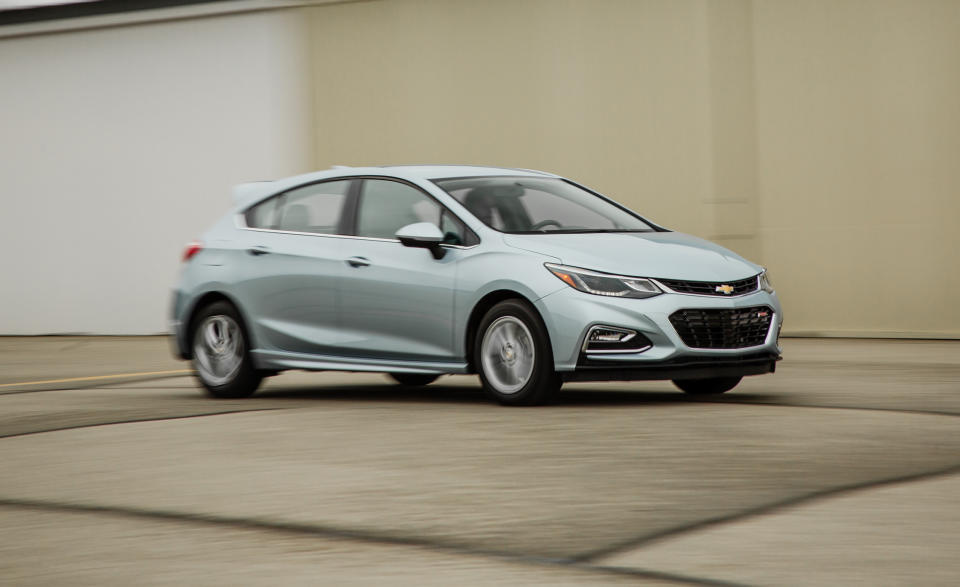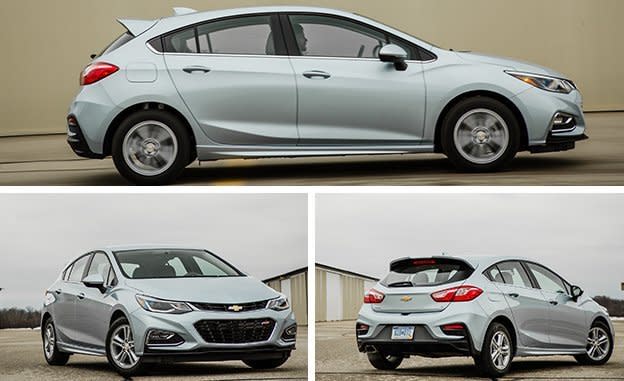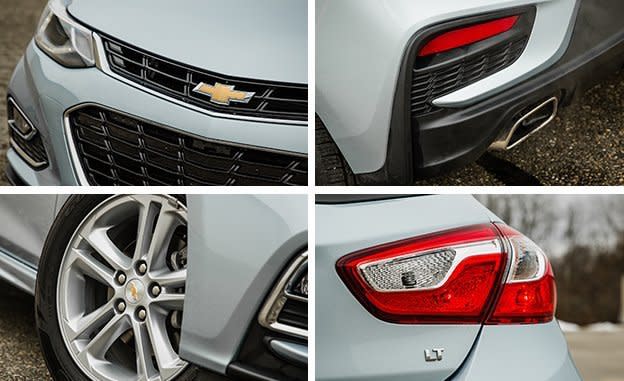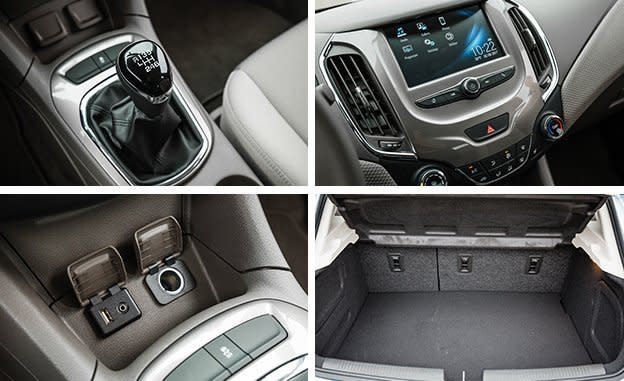2017 Chevrolet Cruze Hatchback Manual

Being the new kid in a school can be one of the toughest transitions of a lifetime. The sleek second-generation Chevrolet Cruze arrived in 2016 in sedan-form only. For 2017, the model is available in one of our favorite body styles—the hatchback—for the first time in North America. And Chevrolet even sees fit to make this creation available with an actual clutch pedal. They’re speaking our language. Arriving late to a well-established class, the Cruze is looking for a spot on the dean’s list.
Wherefore Art Thou, Turbo?
The badging on the Chevrolet Cruze LT RS that we tested indicates the new hatch may be struggling to find itself; LT might just as well stand for Lacking Torque. Power for this Cruze comes from a new turbocharged 1.4-liter inline-four producing 153 horsepower. Chevy says peak torque is 177 lb-ft at 2000 rpm, but it feels as if its force quickly falls off the chart at 2001 rpm and never returns; the lack of thrust had us opening the hood to make sure there was indeed a turbo attached to the manifold. Spirited driving through the Angeles National Forest often required the accelerator pedal to be pushed into the engine bay in order to maintain pace.

Our affection for the manual transmission is well established, and we give props to Chevy for offering one on the Cruze, a car aimed at young buyers so digital that they often can’t read analog clocks. Really enjoying a manual, though, demands that the car have an appealing shifter mechanism, and the Cruze’s, topped with a large, hard plastic shift knob the size of a computer mouse, does not make the cut. A giant reverse-lockout trigger on the backside of the shifter is more distracting and odd than a fidget spinner, and the shifter’s action and feel are more utilitarian than pleasing.
Hang On, We’ll Get There
At the test facility, the Cruze failed to make the track and field team. The RS badge historically has designated a Rally Sport trim, but these days there’s not much that’s sporty about a car requiring 8.3 seconds to reach 60 mph from rest. The longtime all-star Volkswagen Golf in Wolfsburg trim only needs 6.6 seconds. This hatchback with a stick is also 0.6 second slower than the equivalent automatic we’ve tested. The sprint to complete the quarter-mile consumed 16.4 seconds, crossing the line at 88 mph, again falling behind the automatic by 0.4 second (although the manual was 1 mph slower). Aside from the sluggish acceleration, the Cruze’s traction-control system, even when turned off, intervenes early and often. All hopes of strong thrust are thus sent to detention.
Our 400-mile drive under mixed conditions returned an average of 26 mpg, 5 mpg shy of the EPA’s combined rating. During our 75-mph, 200-mile highway driving test, we averaged 34 mpg, once again falling short of the EPA rating, this time by 3 mpg.

While many compact cars have gone to a multilink rear-suspension setup, the Cruze still utilizes a torsion beam. Our test car was not equipped with Chevrolet’s Z-link—more commonly known as a Panhard bar—superior hardware that’s only available on the Cruze in its Premier trim. The basic Cruze suspension is well sorted, though, and body motions are subdued in corners and road disturbances are absorbed with little fuss.
Riding on Goodyear Assurance 205/55R-16 rubber, the tall sidewalls mask impacts from expansion joints and rough surfaces while returning a skidpad number of 0.85 g, on par with most competitors, setting aside the Honda Civic Sport’s extraordinary 0.93 g of grip. During our punishing braking tests the pedal remained firm and steady, but the car needed 171 feet to stop from 70 mph, or 10 feet more than the automatic Cruze equipped with 17-inch wheels and Firestone Firehawk rubber.
C for Commuter Grade
While the steering offers little feedback, it is direct, maintains course on center, and has a light effort, making it easy to use over the long commute. Those not interested in being the quickest off the line will enjoy the library-quiet interior and compliant ride.

Despite a blandly designed cabin filled with materials of a quality behind that of many competitors, the seats provide all-day comfort and the controls are readily accessible and easy to figure out. At highway speed, the interior of the Cruze is a serene environment, recording just 65 decibels. The only option fitted to our test car was the $850 Convenience Package, which adds a power driver’s seat, keyless entry, push-button start, and heated front seats.
With an as-tested price of $22,965 (a base price of $22,115 plus the aforementioned option package), the manually equipped Chevrolet Cruze struggles to make the grade within its class. A recent comparison test did not produce a positive report card for the handsome hatchback, with it landing fourth behind the Golf, Mazda 3, and Honda Civic hatchbacks. Though the Cruze struggles to fit in among either the luxury or sporty cliques, being a comfortable commuter with average grades isn’t the worst fate for a newcomer.
Specifications >
VEHICLE TYPE: front-engine, front-wheel-drive, 5-passenger, 4-door hatchback
PRICE AS TESTED: $22,965 (base price: $22,115)
ENGINE TYPE: turbocharged and intercooled DOHC 16-valve inline-4, aluminum block and head, direct fuel injection
Displacement: 85 cu in, 1399 cc
Power: 153 hp @ 5600 rpm
Torque: 177 lb-ft @ 2000 rpm
TRANSMISSION: 6-speed manual
DIMENSIONS:
Wheelbase: 106.3 in
Length: 175.3 in
Width: 70.5 in Height: 57.7 in
Passenger volume: 94 cu ft
Cargo volume: 25 cu ft
Curb weight: 2881 lb
C/D TEST RESULTS:
Zero to 60 mph: 8.3 sec
Zero to 100 mph: 23.0 sec
Zero to 120 mph: 38.7 sec
Rolling start, 5–60 mph: 9.0 sec
Top gear, 30–50 mph: 22.5 sec
Top gear, 50–70 mph: 13.1 sec
Standing ¼-mile: 16.4 sec @ 88 mph
Top speed (governor limited): 132 mph
Braking, 70–0 mph: 171 ft
Roadholding, 300-ft-dia skidpad*: 0.85 g
FUEL ECONOMY:
EPA combined/city/highway: 31/28/37 mpg
C/D observed: 26 mpg
C/D observed 75-mph highway driving: 34 mpg
C/D observed highway range: 460 mi
*stability-control-inhibited

 Yahoo Autos
Yahoo Autos 